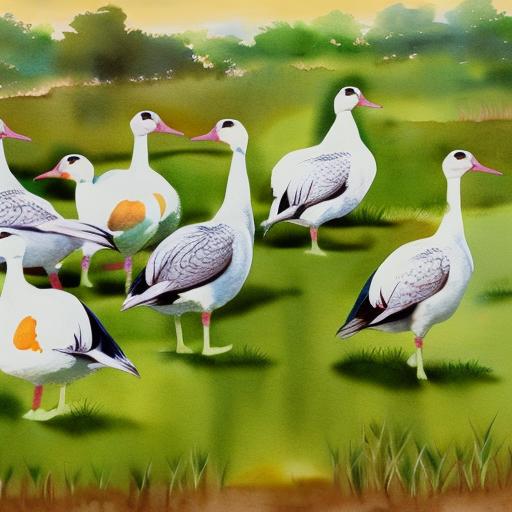Indian Runner Ducks are a unique and fascinating breed of domestic duck that originated in the Indian subcontinent. They are known for their upright, penguin-like stance and their distinctive long, slender bodies. Indian Runners are excellent foragers and are often used for pest control in gardens and farms. They are also prolific egg layers, making them a popular choice for small-scale egg production.
These ducks come in a variety of colors, including fawn and white, black, and chocolate. They are generally friendly and sociable birds, making them a great addition to a backyard flock. Indian Runners are also known for their high energy levels and love of exploring their surroundings. They are not particularly good fliers, so they are best kept in a secure enclosure to prevent them from wandering off.
Indian Runner Ducks are relatively low maintenance and can adapt well to a variety of climates. They are hardy birds that can thrive in both free-range and confined environments. However, they do require access to water for bathing and foraging, as well as protection from predators. Overall, Indian Runner Ducks are a versatile and charming breed that can make a valuable addition to any small farm or homestead.
Key Takeaways
- Indian Runner Ducks are a unique breed known for their upright posture and excellent egg-laying abilities.
- When selecting breeding stock, look for ducks with good conformation, strong legs, and healthy plumage.
- Creating the right breeding environment involves providing ample space, clean water, and a balanced diet for the ducks.
- Managing breeding behavior includes ensuring proper mating, preventing aggression, and providing nesting areas for the ducks.
- Incubating and hatching eggs requires maintaining proper temperature and humidity levels, as well as regular turning of the eggs.
Selecting Breeding Stock
When selecting breeding stock for Indian Runner Ducks, it is important to choose birds that exhibit the desired traits for the breed. Look for ducks that have a strong, upright stance, a long, slender body, and a smooth, streamlined appearance. The legs should be set well apart and the feet should be straight and well-positioned. Additionally, the head should be held high and the bill should be long and straight.
It is also important to consider the color and markings of the ducks when selecting breeding stock. Choose birds that have vibrant, well-defined colors and patterns that are characteristic of the breed. Avoid ducks with any physical deformities or abnormalities, as these traits can be passed on to future generations.
When selecting breeding stock, it is also important to consider the health and temperament of the ducks. Look for birds that are active, alert, and in good overall condition. Avoid ducks that show signs of illness or injury, as these traits can also be passed on to their offspring.
Overall, selecting breeding stock for Indian Runner Ducks requires careful consideration of both physical traits and overall health. By choosing ducks that exhibit the desired characteristics of the breed, you can help ensure the production of healthy, high-quality offspring.
Creating the Right Breeding Environment
Creating the right breeding environment for Indian Runner Ducks is essential for successful breeding and egg production. Ducks should be provided with a secure and comfortable space that allows for natural mating behaviors and nesting. A well-designed breeding environment will help minimize stress and encourage healthy breeding behaviors.
Provide ducks with a spacious enclosure that includes access to water for bathing and foraging. Ducks should also have access to a variety of natural materials, such as straw or grass, for building nests. Additionally, nesting boxes or shelters should be provided to give ducks a safe and private space for laying eggs.
It is important to ensure that the breeding environment is free from potential hazards and predators. Secure fencing and predator-proof shelters can help protect ducks from harm and reduce stress during the breeding process. Additionally, providing ample food and clean water will help support the health and well-being of breeding ducks.
By creating a comfortable and secure breeding environment, you can help encourage natural breeding behaviors and improve the overall success of your Indian Runner Duck breeding program.
Managing Breeding Behavior
Managing breeding behavior in Indian Runner Ducks requires careful observation and attention to the needs of the breeding flock. Ducks should be provided with ample space, access to water, and appropriate nesting materials to encourage natural mating behaviors and egg laying.
During the breeding season, male ducks may become more aggressive as they compete for mates. It is important to monitor the behavior of male ducks and separate any individuals that display excessive aggression towards females. Providing multiple females for each male can help reduce competition and minimize aggressive behavior.
It is also important to monitor the nesting behavior of female ducks to ensure that they have access to suitable nesting sites. Ducks should be provided with private, quiet spaces for laying eggs, such as nesting boxes or shelters. Regularly check nesting areas for eggs and remove any that are damaged or soiled to prevent contamination.
Overall, managing breeding behavior in Indian Runner Ducks requires careful observation and proactive measures to support natural mating behaviors and egg production. By providing a comfortable and secure environment, you can help minimize stress and encourage healthy breeding behaviors in your flock.
Incubating and Hatching Eggs
Incubating and hatching Indian Runner Duck eggs requires careful attention to temperature, humidity, and turning of the eggs. Duck eggs typically take around 28 days to hatch, but this can vary depending on environmental conditions and the specific breed of duck.
When incubating duck eggs, it is important to maintain a consistent temperature of around 99-100 degrees Fahrenheit and a humidity level of around 55-60%. Use a reliable egg incubator to ensure that these conditions are met consistently throughout the incubation period.
Duck eggs should also be turned regularly during the incubation process to prevent the embryos from sticking to the shell membrane. Turn the eggs at least three times a day until day 25 of incubation, at which point they should be left undisturbed until hatching.
Once the ducklings begin to hatch, it is important to provide them with a warm, clean environment to promote healthy development. A brooder with a heat lamp or heat pad can help maintain a consistent temperature of around 90-95 degrees Fahrenheit for the first week of life.
By carefully monitoring temperature, humidity, and turning of the eggs, you can help ensure a successful incubation and hatching process for Indian Runner Duck eggs.
Caring for Ducklings

Caring for Indian Runner Ducklings requires attention to their nutritional needs, housing requirements, and overall health and well-being. Ducklings should be provided with a warm, clean environment that includes access to food, water, and protection from predators.
Ducklings require a high-protein diet to support healthy growth and development. Provide ducklings with a commercial duck starter feed that contains around 18-20% protein. Additionally, offer fresh water in shallow containers that are easy for ducklings to access without risk of drowning.
Adequate housing is essential for the health and safety of ducklings. Provide a brooder with a heat lamp or heat pad to maintain a consistent temperature of around 90-95 degrees Fahrenheit for the first week of life. As ducklings grow, gradually reduce the temperature by around 5 degrees each week until they are fully feathered.
Regularly monitor the health of ducklings for signs of illness or injury. Provide veterinary care as needed to address any health concerns and ensure that ducklings receive appropriate vaccinations and parasite control.
By providing a warm, clean environment and meeting the nutritional needs of ducklings, you can help ensure their healthy growth and development into thriving adult ducks.
Troubleshooting Common Breeding Issues
Breeding Indian Runner Ducks can present various challenges that require proactive management and troubleshooting. Common issues such as low egg production, fertility problems, or aggressive behavior among ducks may arise during the breeding process.
Low egg production can be caused by factors such as inadequate nutrition, stress, or environmental conditions. Ensure that ducks are provided with a balanced diet, access to clean water, and a comfortable living environment to support healthy egg production.
Fertility problems may occur if male ducks are unable to successfully mate with females. Monitor mating behavior closely and consider providing additional females for each male to improve fertility rates.
Aggressive behavior among ducks can lead to injuries or stress within the flock. Provide ample space and resources to minimize competition among ducks and consider separating aggressive individuals if necessary.
By identifying and addressing common breeding issues proactively, you can help ensure the success of your Indian Runner Duck breeding program and promote the health and well-being of your flock.
If you’re interested in breeding Indian Runner ducks, you may also want to consider the importance of providing a suitable environment for your poultry. A large chicken coop can offer the space and comfort necessary for successful breeding and raising of ducks. Check out this article on large chicken coop ideas to ensure that your ducks have the right living space to thrive.
FAQs
What are Indian Runner ducks?
Indian Runner ducks are a domestic breed of duck that originated in the Indian subcontinent. They are known for their upright posture and distinctive tall, slender body shape.
What is the purpose of breeding Indian Runner ducks?
Breeding Indian Runner ducks can serve various purposes, including egg production, pest control in gardens and farms, and as ornamental or show birds.
What are the key considerations for breeding Indian Runner ducks?
Key considerations for breeding Indian Runner ducks include providing a suitable environment for breeding, ensuring proper nutrition and care for the ducks, and selecting breeding stock with desirable traits.
What is the breeding season for Indian Runner ducks?
Indian Runner ducks typically breed in the spring and summer months, with peak egg production occurring during this time.
How do you encourage breeding in Indian Runner ducks?
To encourage breeding in Indian Runner ducks, it is important to provide a suitable nesting area, a balanced diet, and a stress-free environment. Additionally, ensuring that the ducks have access to clean water and ample space can also encourage breeding behavior.
What are some common health issues to watch for when breeding Indian Runner ducks?
Common health issues to watch for when breeding Indian Runner ducks include respiratory infections, bumblefoot, and egg binding in females. It is important to monitor the ducks closely and seek veterinary care if any health concerns arise.
What are some tips for successful breeding of Indian Runner ducks?
Some tips for successful breeding of Indian Runner ducks include providing a balanced diet, ensuring proper housing and nesting areas, monitoring the ducks for signs of illness or stress, and selecting breeding stock with desirable traits such as good egg production and strong, healthy offspring.
Meet Walter, the feathered-friend fanatic of Florida! Nestled in the sunshine state, Walter struts through life with his feathered companions, clucking his way to happiness. With a coop that’s fancier than a five-star hotel, he’s the Don Juan of the chicken world. When he’s not teaching his hens to do the cha-cha, you’ll find him in a heated debate with his prized rooster, Sir Clucks-a-Lot. Walter’s poultry passion is no yolk; he’s the sunny-side-up guy you never knew you needed in your flock of friends!







